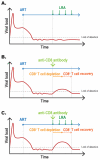Potential Utility of Natural Killer Cells for Eliminating Cells Harboring Reactivated Latent HIV-1 Following the Removal of CD8+ T Cell-Mediated Pro-Latency Effect(s)
- PMID: 34452317
- PMCID: PMC8402732
- DOI: 10.3390/v13081451
Potential Utility of Natural Killer Cells for Eliminating Cells Harboring Reactivated Latent HIV-1 Following the Removal of CD8+ T Cell-Mediated Pro-Latency Effect(s)
Abstract
An impediment to curing HIV-1 infection is the persistence of latently infected cells in ART-treated people living with HIV (PLWH). A key strategy for curing HIV-1 infection is to activate transcription and translation of latent virus using latency reversing agents (LRAs) and eliminate cells harboring reactivated virus via viral cytopathic effect or immune clearance. In this review, we provide an overview of available LRAs and their use in clinical trials. Furthermore, we describe recent data suggesting that CD8+ T cells promote HIV-1 latency in the context of ART, even in the presence of LRAs, which might at least partially explain the clinical inefficiency of previous "shock and kill" trials. Here, we propose a novel cure strategy called "unlock, shock, disarm, and kill". The general premise of this strategy is to shut down the pro-latency function(s) of CD8+ T cells, use LRAs to reverse HIV-1 latency, counteract anti-apoptotic molecules, and engage natural killer (NK) cells to mediate the killing of cells harboring reactivated latent HIV-1.
Keywords: CD8+ T cells; HIV-1 cure; HIV-1 latency; NK cells.
Conflict of interest statement
The authors declare no conflict of interest.
Figures



Similar articles
-
TLR1/2 Agonist Enhances Reversal of HIV-1 Latency and Promotes NK Cell-Induced Suppression of HIV-1-Infected Autologous CD4+ T Cells.J Virol. 2021 Aug 10;95(17):e0081621. doi: 10.1128/JVI.00816-21. Epub 2021 Aug 10. J Virol. 2021. PMID: 34133900 Free PMC article.
-
The HIV Latency Reversal Agent HODHBt Enhances NK Cell Effector and Memory-Like Functions by Increasing Interleukin-15-Mediated STAT Activation.J Virol. 2022 Aug 10;96(15):e0037222. doi: 10.1128/jvi.00372-22. Epub 2022 Jul 14. J Virol. 2022. PMID: 35867565 Free PMC article.
-
Interferon Alpha Enhances NK Cell Function and the Suppressive Capacity of HIV-Specific CD8+ T Cells.J Virol. 2019 Jan 17;93(3):e01541-18. doi: 10.1128/JVI.01541-18. Print 2019 Feb 1. J Virol. 2019. PMID: 30404799 Free PMC article.
-
Shocking HIV-1 with immunomodulatory latency reversing agents.Semin Immunol. 2021 Jan;51:101478. doi: 10.1016/j.smim.2021.101478. Epub 2021 May 8. Semin Immunol. 2021. PMID: 33972164 Review.
-
Potential of the NKG2D/NKG2DL Axis in NK Cell-Mediated Clearance of the HIV-1 Reservoir.Int J Mol Sci. 2019 Sep 11;20(18):4490. doi: 10.3390/ijms20184490. Int J Mol Sci. 2019. PMID: 31514330 Free PMC article. Review.
Cited by
-
Immune-mediated strategies to solving the HIV reservoir problem.Nat Rev Immunol. 2025 Jul;25(7):542-553. doi: 10.1038/s41577-025-01136-7. Epub 2025 Feb 13. Nat Rev Immunol. 2025. PMID: 39948261 Review.
References
-
- Gulick R.M., Mellors J.W., Havlir D., Eron J.J., Gonzalez C., McMahon D., Richman D.D., Valentine F.T., Jonas L., Meibohm A., et al. Treatment with indinavir, zidovudine, and lamivudine in adults with human immunodeficiency virus infection and prior antiretroviral therapy. N. Engl. J. Med. 1997;337:734–739. doi: 10.1056/NEJM199709113371102. - DOI - PubMed
-
- Palella F.J., Jr., Delaney K.M., Moorman A.C., Loveless M.O., Fuhrer J., Satten G.A., Aschman D.J., Holmberg S.D. HIV Outpatient Study Investigators. Declining morbidity and mortality among patients with advanced human immunodeficiency virus infection. N. Engl. J. Med. 1998;338:853–860. doi: 10.1056/NEJM199803263381301. - DOI - PubMed
-
- Finzi D., Hermankova M., Pierson T., Carruth L.M., Buck C., Chaisson R.E., Quinn T.C., Chadwick K., Margolick J., Brookmeyer R., et al. Identification of a reservoir for HIV-1 in patients on highly active antiretroviral therapy. Science. 1997;278:1295–1300. doi: 10.1126/science.278.5341.1295. - DOI - PubMed
-
- Colby D.J., Trautmann L., Pinyakorn S., Leyre L., Pagliuzza A., Kroon E., Rolland M., Takata H., Buranapraditkun S., Intasan J., et al. Rapid HIV RNA rebound after antiretroviral treatment interruption in persons durably suppressed in Fiebig I acute HIV infection. Nat. Med. 2018;24:923–926. doi: 10.1038/s41591-018-0026-6. - DOI - PMC - PubMed
Publication types
MeSH terms
Grants and funding
LinkOut - more resources
Full Text Sources
Medical
Research Materials

